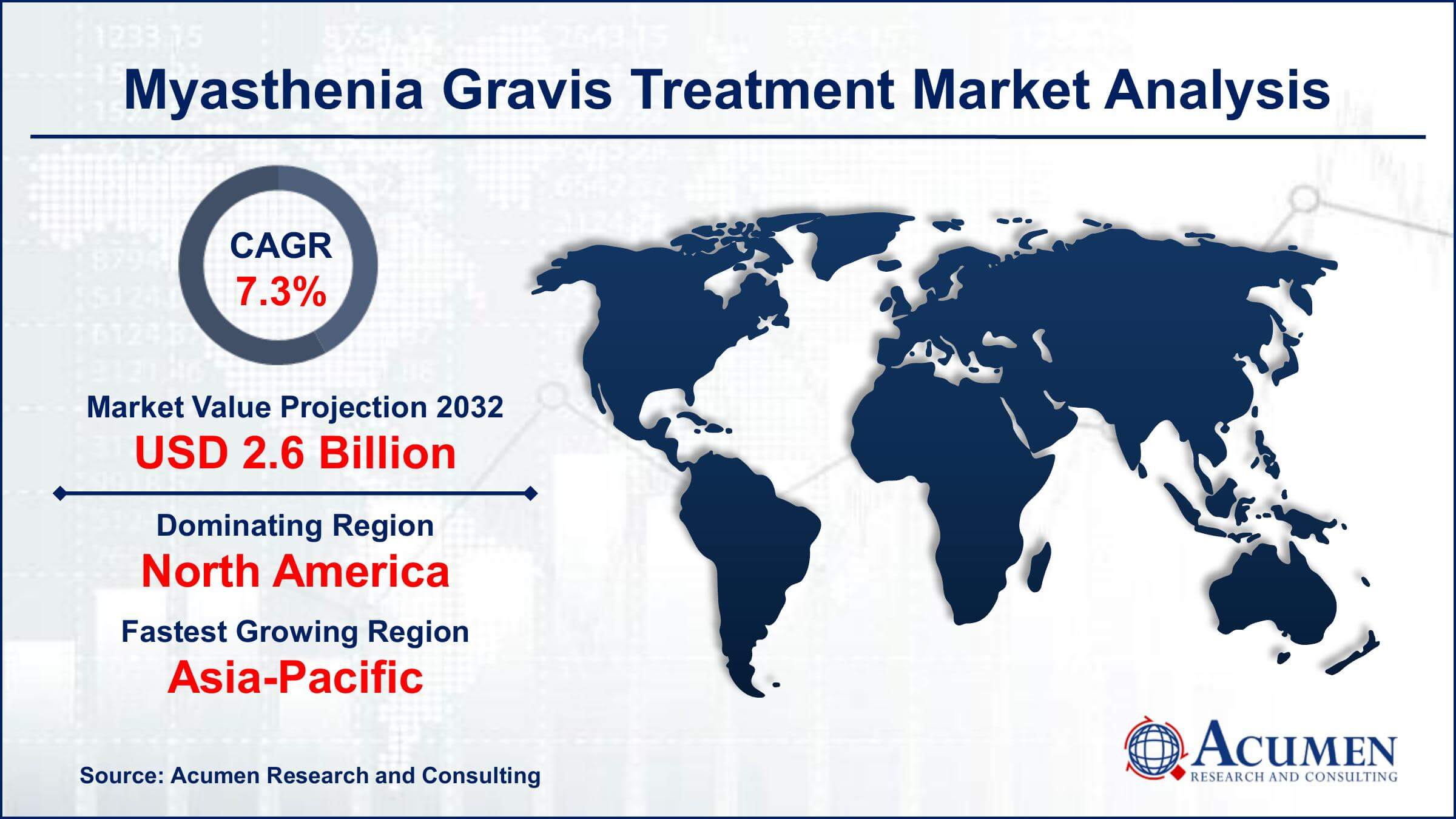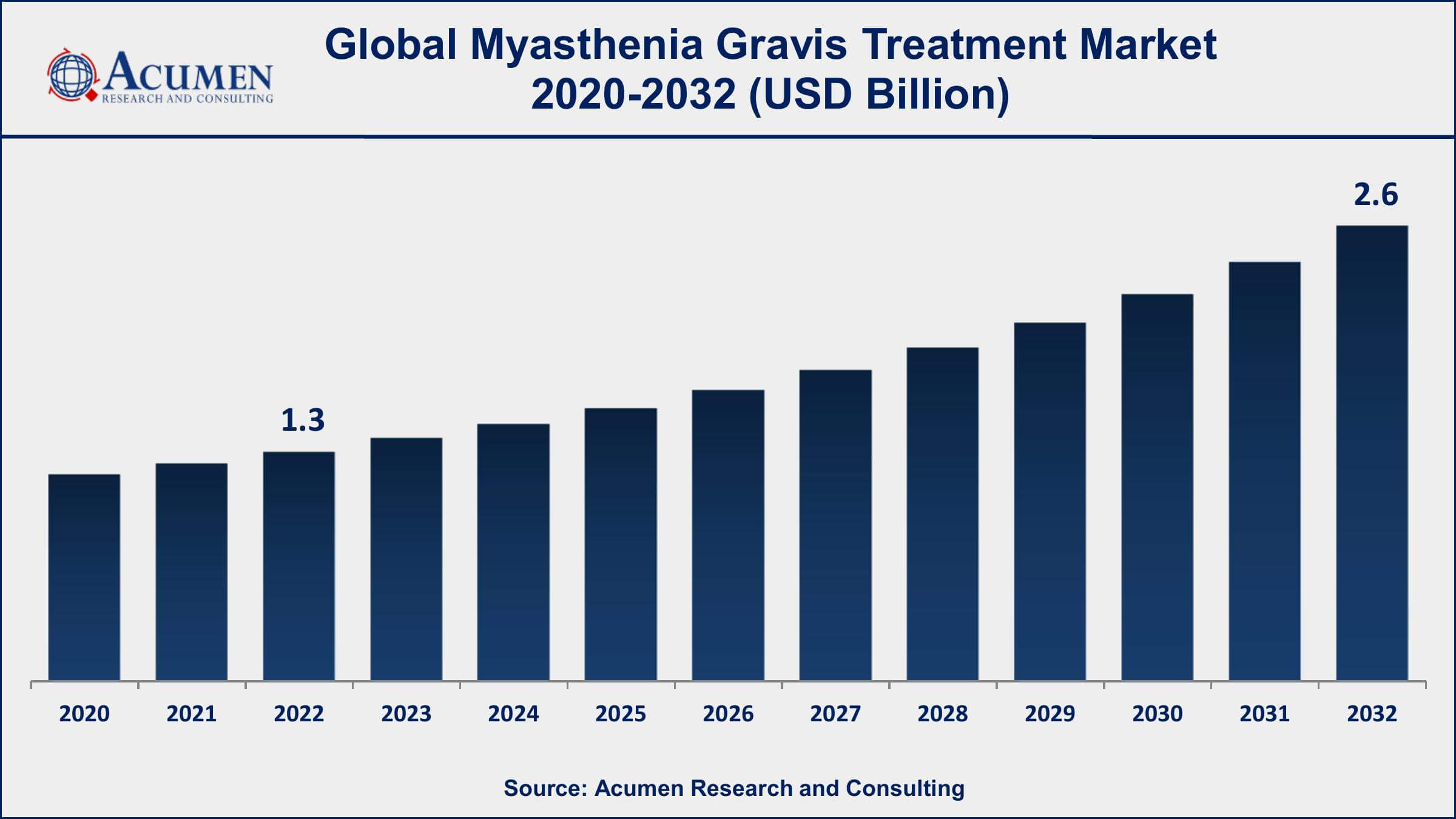Myasthenia Gravis Treatment Market Size - Global Industry, Share, Analysis, Trends and Forecast 2023 - 2032
Published :
Report ID:
Pages :
Format :
Myasthenia Gravis Treatment Market Size - Global Industry, Share, Analysis, Trends and Forecast 2023 - 2032
Report Coverage
- Industry Dynamics
- Market Size and Forecast Data
- Segment Analysis
- Competitive Landscape
- Regional Analysis with a Niche Focus on Country-Level Data
- High Level Analysis - Porter's, PESTEL, Value Chain, etc.
- Company Profiles of Key Players
- Option to Customize the Report As Per Your Specific Need
Request Sample Report
The Global Myasthenia Gravis Treatment Market Size accounted for USD 1.3 Billion in 2022 and is projected to achieve a market size of USD 2.6 Billion by 2032 growing at a CAGR of 7.3% from 2023 to 2032.
Myasthenia Gravis Treatment Market Highlights
- Global Myasthenia Gravis Treatment Market revenue is expected to increase by USD 2.6 Billion by 2032, with a 7.3% CAGR from 2023 to 2032
- North America region led with more than 46% of Myasthenia Gravis Treatment Market share in 2022
- According to Myasthenia Gravis Foundation of America 2022 data, more than 70,000 individuals in the US alone are diagnosed with myasthenia gravis
- Asia-Pacific Myasthenia Gravis Treatment Market growth will record a CAGR of around 7.5% from 2023 to 2032
- By drug class, the IVIg is one of the largest and fastest-growing segments of the myasthenia gravis treatment industry
- Rise in demand of effective treatments for myasthenia gravis, drives the myasthenia gravis treatment market value

Myasthenia gravis (MG) is a chronic autoimmune neuromuscular disorder that affects the communication between nerves and muscles. It leads to muscle weakness and fatigue, primarily affecting voluntary muscles, including those used for swallowing, speaking, and controlling facial expressions. The treatment of MG primarily aims to alleviate symptoms, improve muscle function, and manage the autoimmune response responsible for the condition. Common treatments include acetylcholinesterase inhibitors (e.g., pyridostigmine), immunosuppressive drugs (such as corticosteroids and azathioprine), plasma exchange, intravenous immunoglobulin (IVIG) therapy, and, in some cases, thymectomy (surgical removal of the thymus gland). Emerging therapies, including monoclonal antibodies like eculizumab and other immunomodulatory drugs, offer promising options for MG patients.
The Myasthenia Gravis treatment market has witnessed steady growth in recent years, driven by several factors. An increase in the diagnosis rate, better understanding of the disease, and advances in treatment options have contributed to the expansion of the market. Additionally, pharmaceutical companies have been investing in research and development to introduce novel therapies with improved efficacy and fewer side effects. The global MG treatment market is expected to continue growing as the demand for more effective and safer treatment options persists, particularly with the emergence of biologics and targeted therapies.

Global Myasthenia Gravis Treatment Market Trends
Market Drivers
- Increasing prevalence of myasthenia gravis
- Advancements in treatment options and therapies
- Rising awareness and early diagnosis
- Growing research and development efforts
- Expansion of healthcare infrastructure
Market Restraints
- High treatment costs
- Limited availability of specific therapies
- Adverse side effects associated with some treatments
Market Opportunities
- Development of targeted and biologic therapies
- Personalized medicine approaches
- Telemedicine and remote patient monitoring
Myasthenia Gravis Treatment Market Report Coverage
| Market | Myasthenia Gravis Treatment Market |
| Myasthenia Gravis Treatment Market Size 2022 | USD 1.3 Billion |
| Myasthenia Gravis Treatment Market Forecast 2032 | USD 2.6 Billion |
| Myasthenia Gravis Treatment Market CAGR During 2023 - 2032 | 7.3% |
| Myasthenia Gravis Treatment Market Analysis Period | 2020 - 2032 |
| Myasthenia Gravis Treatment Market Base Year |
2022 |
| Myasthenia Gravis Treatment Market Forecast Data | 2023 - 2032 |
| Segments Covered | By Drug Class, By Distribution Channel, And By Geography |
| Regional Scope | North America, Europe, Asia Pacific, Latin America, and Middle East & Africa |
| Key Companies Profiled | Alexion Pharmaceuticals, Inc., Grifols, S.A., Bausch Health Companies Inc. (formerly Valeant Pharmaceuticals), Mylan N.V. (now part of Viatris Inc.), Roche Holdings AG (including its subsidiary, Genentech), Takeda Pharmaceutical Company Limited, Novartis AG, Pfizer Inc., Bristol-Myers Squibb Company (now part of Bristol Myers Squibb), Teva Pharmaceutical Industries Ltd., AbbVie Inc., and Regeneron Pharmaceuticals, Inc. |
| Report Coverage |
Market Trends, Drivers, Restraints, Competitive Analysis, Player Profiling, Covid-19 Analysis, Regulation Analysis |
Myasthenia Gravis Treatment Market Dynamics
Myasthenia gravis (MG) is an autoimmune neuromuscular disorder characterized by muscle weakness and fatigue. The underlying cause of MG is the production of antibodies that target and interfere with the normal functioning of acetylcholine receptors at the neuromuscular junction, where nerves connect with muscles. This disruption in communication between nerves and muscles leads to muscle weakness, particularly in the muscles responsible for facial expressions, swallowing, and limb movements.
The treatment of myasthenia gravis is primarily aimed at managing symptoms, improving muscle function, and suppressing the autoimmune response. Common treatment options include acetylcholinesterase inhibitors like pyridostigmine, which enhance nerve signaling to muscles, providing temporary relief. Immunosuppressive drugs such as corticosteroids and azathioprine may be prescribed to suppress the immune system's overactivity. In severe cases or when medications are not effective, therapies like plasma exchange and intravenous immunoglobulin (IVIG) can help remove harmful antibodies from the bloodstream. Surgical removal of the thymus gland (thymectomy) may also be recommended for certain patients, as the thymus is believed to play a role in the development of MG.
The Myasthenia Gravis (MG) treatment market has been experiencing steady growth in recent years and is poised for further expansion. Several factors are contributing to this growth. First and foremost is the increasing prevalence of MG, which is leading to a higher demand for treatment options. As awareness about the condition improves and diagnostic capabilities become more sophisticated, more individuals are being diagnosed with MG, thus fueling market growth. Advancements in treatment options and therapies are another major driver of market growth. Pharmaceutical companies are investing in research and development to introduce innovative therapies with improved efficacy and fewer side effects. Biologics, monoclonal antibodies, and targeted therapies are among the promising treatments being explored. Additionally, the expansion of healthcare infrastructure, especially in emerging markets, is providing better access to MG treatments, further driving market growth.
Myasthenia Gravis Treatment Market Segmentation
The global Myasthenia Gravis Treatment Market segmentation is based on drug class, distribution channel, and geography.
Myasthenia Gravis Treatment Market By Drug Class
- Corticosteroids
- IVIg
- Cholinesterase Inhibitors
- Immunosuppressants
- Monoclonal Antibodies
In terms of drug classes, the IVIg segment accounted for the largest market share in 2022. Intravenous Immunoglobulin (IVIg) therapy involves the intravenous infusion of immunoglobulin antibodies derived from healthy donors, and it has shown effectiveness in managing MG symptoms by temporarily modulating the immune system. One of the primary reasons for the growth of the IVIg segment is its proven efficacy in rapidly improving muscle strength and overall neuromuscular function in MG patients, particularly during myasthenic crises or exacerbations. IVIg therapy has become a standard treatment in these critical situations, providing quick relief and stabilizing patients' conditions. Additionally, IVIg is considered a safer alternative to other immunosuppressive drugs, as it does not carry the long-term risks associated with prolonged steroid use or other immunosuppressants. The expansion of healthcare infrastructure and improved access to specialized care centers have also contributed to the growth of IVIg usage in MG treatment.
Myasthenia Gravis Treatment Market By Distribution Channel
- Hospital Pharmacies
- Online Pharmacies
- Retail Pharmacies
According to the myasthenia gravis treatment market forecast, the hospital pharmacies segment is expected to witness significant growth in the coming years. Hospital pharmacies play a pivotal role in the management of MG, as they are responsible for dispensing and administering medications, including immunosuppressants, acetylcholinesterase inhibitors, and intravenous immunoglobulin (IVIg), which are commonly used in MG treatment. One significant driver of growth in this segment is the increasing prevalence of MG, leading to a higher number of patients seeking medical care in hospitals. As the awareness of MG continues to grow, more individuals are being diagnosed and referred to hospital-based healthcare providers for specialized treatment. This increased patient flow results in higher demand for MG medications and therapies, driving the growth of hospital pharmacies. Moreover, advancements in MG treatment options and the introduction of novel therapies have expanded the range of medications available.
Myasthenia Gravis Treatment Market Regional Outlook
North America
- U.S.
- Canada
Europe
- U.K.
- Germany
- France
- Spain
- Rest of Europe
Asia-Pacific
- India
- Japan
- China
- Australia
- South Korea
- Rest of Asia-Pacific
Latin America
- Brazil
- Mexico
- Rest of Latin America
The Middle East & Africa
- South Africa
- GCC Countries
- Rest of the Middle East & Africa (ME&A)
Myasthenia Gravis Treatment Market Regional Analysis
North America has emerged as the dominating region in the Myasthenia Gravis (MG) treatment market for several key reasons. One of the primary factors is the high prevalence of MG in this region. North America has a relatively larger population compared to other regions, and the well-established healthcare infrastructure ensures that a significant number of MG cases are diagnosed and treated. This high disease burden has attracted pharmaceutical companies and researchers to invest in MG research and drug development, leading to a wide range of treatment options available to patients. Another critical factor is the robust healthcare reimbursement system in North America. Many MG treatments, including expensive therapies such as intravenous immunoglobulin (IVIg) and thymectomy, are often covered by health insurance plans, making them more accessible to a broader patient population. This financial support alleviates the burden on patients and encourages timely treatment, contributing to the dominance of North America in the MG treatment market. Furthermore, North America is home to some of the world's leading pharmaceutical and biotechnology companies that have played a significant role in advancing MG treatments.
Myasthenia Gravis Treatment Market Player
Some of the top myasthenia gravis treatment market companies offered in the professional report include Alexion Pharmaceuticals, Inc., Grifols, S.A., Bausch Health Companies Inc. (formerly Valeant Pharmaceuticals), Mylan N.V. (now part of Viatris Inc.), Roche Holdings AG (including its subsidiary, Genentech), Takeda Pharmaceutical Company Limited, Novartis AG, Pfizer Inc., Bristol-Myers Squibb Company (now part of Bristol Myers Squibb), Teva Pharmaceutical Industries Ltd., AbbVie Inc., and Regeneron Pharmaceuticals, Inc.
Frequently Asked Questions
What was the market size of the global myasthenia gravis treatment in 2022?
The market size of myasthenia gravis treatment was USD 1.3 Billion in 2022.
What is the CAGR of the global myasthenia gravis treatment market from 2023 to 2032?
The CAGR of myasthenia gravis treatment is 7.3% during the analysis period of 2023 to 2032.
Which are the key players in the myasthenia gravis treatment market?
The key players operating in the global market are including Alexion Pharmaceuticals, Inc., Grifols, S.A., Bausch Health Companies Inc. (formerly Valeant Pharmaceuticals), Mylan N.V. (now part of Viatris Inc.), Roche Holdings AG (including its subsidiary, Genentech), Takeda Pharmaceutical Company Limited, Novartis AG, Pfizer Inc., Bristol-Myers Squibb Company (now part of Bristol Myers Squibb), Teva Pharmaceutical Industries Ltd., AbbVie Inc., and Regeneron Pharmaceuticals, Inc.
Which region dominated the global myasthenia gravis treatment market share?
North America held the dominating position in myasthenia gravis treatment industry during the analysis period of 2023 to 2032.
Which region registered fastest CAGR from 2023 to 2032?
Asia-Pacific region exhibited fastest growing CAGR for market of myasthenia gravis treatment during the analysis period of 2023 to 2032.
What are the current trends and dynamics in the global myasthenia gravis treatment industry?
The current trends and dynamics in the myasthenia gravis treatment market growth include increasing prevalence of myasthenia gravis, advancements in treatment options and therapies, and rising awareness and early diagnosis.
Which drug class held the maximum share in 2022?
The IVIg drug class held the maximum share of the myasthenia gravis treatment industry.


